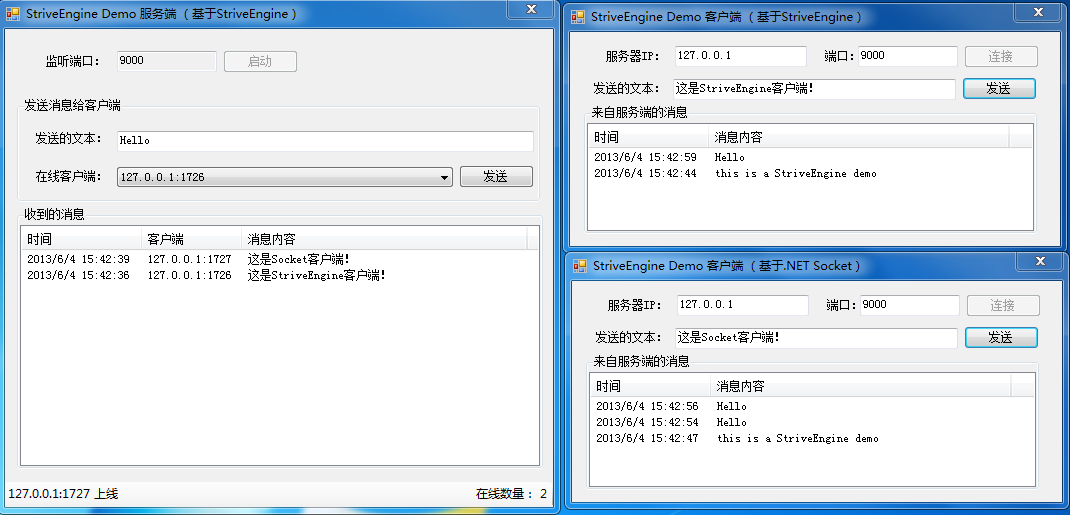客户端服务器通信demo(附源码)
前段时间,有几个研究ESFramework的朋友对我说,ESFramework有点庞大,对于他们目前的项目来说有点“杀鸡用牛刀”的意思,因为他们的项目不需要文件传送、不需要P2P、不存在好友关系、也不存在组广播、不需要服务器均衡、不需要跨服务器通信、甚至都不需要使用UserID,只要客户端能与服务端进行简单的稳定高效的通信就可以了。于是,他们建议我,整一个轻量级的通信组件来满足类似他们这种项目的需求。我觉得这个建议是有道理的,于是,花了几天时间,我将ESFramework的内核抽离出来,经过修改封装后,形成了StriveEngine,其最大的特点就是稳定高效、易于使用。通过下面这个简单的demo,我们应该就能上手了。文末有demo源码下载,我们先上Demo截图:

1.Demo简介
该Demo总共包括三个项目:
1.StriveEngine.SimpleDemoServer:基于StriveEngine开发的服务端。
2.StriveEngine.SimpleDemoClient:基于StriveEngine开发的客户端。
3.StriveEngine.SimpleDemo:直接基于.NET的Socket开发的客户端,其目的是为了演示:在客户端不使用StriveEngine的情况下,如何与基于StriveEngine的服务端进行通信。
StriveEngine 内置支持TCP/UDP、文本协议/二进制协议,该Demo我们使用TCP、文本格式的消息协议,消息的结束符为"\0"。
2.Demo服务端

private ITcpServerEngine tcpServerEngine; private void button1_Click(object sender, EventArgs e) { try { //初始化并启动服务端引擎(TCP、文本协议) this.tcpServerEngine = NetworkEngineFactory.CreateTextTcpServerEngine(int.Parse(this.textBox_port.Text), new DefaultTextContractHelper("\0")); this.tcpServerEngine.ClientCountChanged += new CbDelegate<int>(tcpServerEngine_ClientCountChanged); this.tcpServerEngine.ClientConnected += new CbDelegate<System.Net.IPEndPoint>(tcpServerEngine_ClientConnected); this.tcpServerEngine.ClientDisconnected += new CbDelegate<System.Net.IPEndPoint>(tcpServerEngine_ClientDisconnected); this.tcpServerEngine.MessageReceived += new CbDelegate<IPEndPoint, byte[]>(tcpServerEngine_MessageReceived); this.tcpServerEngine.Initialize(); this.button1.Enabled = false; this.textBox_port.ReadOnly = true; this.button2.Enabled = true; } catch (Exception ee) { MessageBox.Show(ee.Message); } } void tcpServerEngine_MessageReceived(IPEndPoint client, byte[] bMsg) { string msg = System.Text.Encoding.UTF8.GetString(bMsg); //消息使用UTF-8编码 msg = msg.Substring(0, msg.Length - 1); //将结束标记"\0"剔除 this.ShowClientMsg(client, msg); } void tcpServerEngine_ClientDisconnected(System.Net.IPEndPoint ipe) { string msg = string.Format("{0} 下线", ipe); this.ShowEvent(msg); } void tcpServerEngine_ClientConnected(System.Net.IPEndPoint ipe) { string msg = string.Format("{0} 上线" ,ipe); this.ShowEvent(msg); } void tcpServerEngine_ClientCountChanged(int count) { this.ShowConnectionCount(count); } private void ShowEvent(string msg) { if (this.InvokeRequired) { this.BeginInvoke(new CbDelegate<string>(this.ShowEvent), msg); } else { this.toolStripLabel_event.Text = msg; } } private void ShowClientMsg(IPEndPoint client, string msg) { if (this.InvokeRequired) { this.BeginInvoke(new CbDelegate<IPEndPoint,string>(this.ShowClientMsg),client, msg); } else { ListViewItem item = new ListViewItem(new string[] { DateTime.Now.ToString(), client.ToString(), msg }); this.listView1.Items.Insert(0, item); } } private void ShowConnectionCount(int clientCount) { if (this.InvokeRequired) { this.BeginInvoke(new CbDelegate<int>(this.ShowConnectionCount), clientCount); } else { this.toolStripLabel_clientCount.Text = "在线数量: " + clientCount.ToString(); } } private void comboBox1_DropDown(object sender, EventArgs e) { List<IPEndPoint> list = this.tcpServerEngine.GetClientList(); this.comboBox1.DataSource = list; } private void button2_Click(object sender, EventArgs e) { try { IPEndPoint client = (IPEndPoint)this.comboBox1.SelectedItem; if (client == null) { MessageBox.Show("没有选中任何在线客户端!"); return; } if (!this.tcpServerEngine.IsClientOnline(client)) { MessageBox.Show("目标客户端不在线!"); return; } string msg = this.textBox_msg.Text + "\0";// "\0" 表示一个消息的结尾 byte[] bMsg = System.Text.Encoding.UTF8.GetBytes(msg);//消息使用UTF-8编码 this.tcpServerEngine.SendMessageToClient(client, bMsg); } catch (Exception ee) { MessageBox.Show(ee.Message); } }
关于服务端引擎的使用,主要就以下几点:
(1)首先调用NetworkEngineFactory的CreateTextTcpServerEngine方法创建引擎(服务端、TCP、Text协议)。
(2)根据需要,预定引擎实例的某些事件(如MessageReceived事件)。
(3)调用引擎实例的Initialize方法启动通信引擎。
(4)调用服务端引擎的SendMessageToClient方法,发送消息给客户端。
3.Demo客户端

private ITcpPassiveEngine tcpPassiveEngine; private void button3_Click(object sender, EventArgs e) { try { //初始化并启动客户端引擎(TCP、文本协议) this.tcpPassiveEngine = NetworkEngineFactory.CreateTextTcpPassiveEngine(this.textBox_IP.Text, int.Parse(this.textBox_port.Text), new DefaultTextContractHelper("\0")); this.tcpPassiveEngine.MessageReceived += new CbDelegate<System.Net.IPEndPoint, byte[]>(tcpPassiveEngine_MessageReceived); this.tcpPassiveEngine.AutoReconnect = true;//启动掉线自动重连 this.tcpPassiveEngine.ConnectionInterrupted += new CbDelegate(tcpPassiveEngine_ConnectionInterrupted); this.tcpPassiveEngine.ConnectionRebuildSucceed += new CbDelegate(tcpPassiveEngine_ConnectionRebuildSucceed); this.tcpPassiveEngine.Initialize(); this.button2.Enabled = true; this.button3.Enabled = false; MessageBox.Show("连接成功!"); } catch (Exception ee) { MessageBox.Show(ee.Message); } } void tcpPassiveEngine_ConnectionRebuildSucceed() { if (this.InvokeRequired) { this.BeginInvoke(new CbDelegate(this.tcpPassiveEngine_ConnectionInterrupted)); } else { this.button2.Enabled = true; MessageBox.Show("重连成功。"); } } void tcpPassiveEngine_ConnectionInterrupted() { if (this.InvokeRequired) { this.BeginInvoke(new CbDelegate(this.tcpPassiveEngine_ConnectionInterrupted)); } else { this.button2.Enabled = false; MessageBox.Show("您已经掉线。"); } } void tcpPassiveEngine_MessageReceived(System.Net.IPEndPoint serverIPE, byte[] bMsg) { string msg = System.Text.Encoding.UTF8.GetString(bMsg); //消息使用UTF-8编码 msg = msg.Substring(0, msg.Length - 1); //将结束标记"\0"剔除 this.ShowMessage(msg); } private void ShowMessage(string msg) { if (this.InvokeRequired) { this.BeginInvoke(new CbDelegate<string>(this.ShowMessage), msg); } else { ListViewItem item = new ListViewItem(new string[] { DateTime.Now.ToString(), msg }); this.listView1.Items.Insert(0, item); } } private void button2_Click(object sender, EventArgs e) { string msg = this.textBox_msg.Text + "\0";// "\0" 表示一个消息的结尾 byte[] bMsg = System.Text.Encoding.UTF8.GetBytes(msg);//消息使用UTF-8编码 this.tcpPassiveEngine.SendMessageToServer(bMsg); }
关于客户端引擎的使用,与服务端类似:
(1)首先调用NetworkEngineFactory的CreateTextTcpPassiveEngine方法创建引擎(客户端、TCP、Text协议)。
(2)根据需要,预定引擎实例的某些事件(如MessageReceived、ConnectionInterrupted?事件)。
(3)根据需要,设置引擎实例的某些属性(如AutoReconnect属性)。
(4)调用引擎实例的Initialize方法启动通信引擎。
(5)调用客户端引擎的SendMessageToServer方法,发送消息给服务端。
4.基于Socket的客户端
这个客户端直接基于.NET的Socket进行开发,其目演示了:在客户端不使用StriveEngine的情况下(比如客户端是异构系统),如何与基于StriveEngine的服务端进行通信。该客户端只是粗糙地实现了基本目的,很多细节问题都被忽略,像粘包问题、消息重组、掉线检测等等。而这些问题在实际的应用中,是必需要处理的。(StriveEngine中的客户端和服务端引擎都内置解决了这些问题)。
该客户端的代码就不贴了,大家可以在源码中看到。
5.源码下载
? ??Demo源码下载。
?